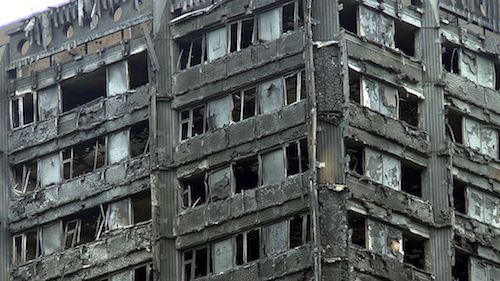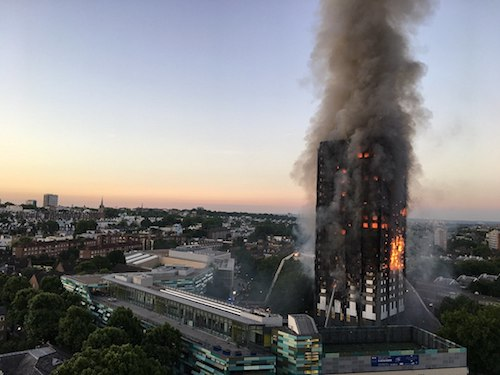Grenfell Inquiry Panelist Resigns Over Conflict
FRIDAY, JANUARY 31, 2020
An expert panelist on the Grenfell Inquiry panel, whose appointment caused outrage among the survivors and families of London’s Grenfell Tower Fire, resigned earlier this week citing a conflict of interest with the manufacturers of the tower’s cladding.
The second phase of the inquiry was slated to start this week.
Some Background
On June 14, 2017, Grenfell Tower—a 24-story, 120-home apartment building—caught fire and resulted in the death of 72 people. While the fire started in a fridge-freezer in an apartment on the fourth floor, the blaze then spread to a nearby window. The building had recently undergone a $12.73 million renovation designed by Studio E Architects that was completed in the spring of 2016 and is largely believed to be responsible for why the fire spread so quickly.
At that time, the building was refurbished with a system of polyester powder-coated aluminum rain-screen panels, insulated exterior cladding and double-glazed windows, as well as a communal heating system.

 |
| ChiralJon, CC-SA-BY 2.0, via Wikimedia Commons |
|
An expert panelist on the Grenfell Inquiry panel, whose appointment cause outrage among the survivors and families of London’s Grenfell Tower Fire, resigned earlier this week citing a conflict of interest with the manufacturers of the tower’s cladding. |
A Guardian investigation in 2018 revealed that nonflammable aluminum panels had initially been proposed for the refurb but were switched out to save money.
The publication found that, at first, under the local government’s preferred contractor, Leadbitter, subcontractor D+B Facades had provided a 3.3 million-pound (roughly $4.1 million) quote to fit a system of aluminum panels backed with mineral wool insulation.
A few months later, the council decided that Leadbitter wanted to spend too much on the refurbishment, and put the contract out to tender to save about 1.3 million pounds. It went with a different contractor, Rydon, which provided a lower bid, but fitted the tower with the combustible cladding that authorities believe contributed to the number of fatalities in the fire.
The Guardian found that the council had originally wanted to spend 6 million pounds on Grenfell, but later set a different budget of 9.7 million pounds, because it realized it needed to replace the heating system. Leadbitter was on course to spend 11.3 million pounds, which is why council says it put the contract back out.
Manufacturer Omnis Exteriors confirmed that they supplied the Arconic Architectural Product to Harley Facades—the subcontractor that Rydon utilized for the cladding work.
Around the same time in 2018, BBC News uncovered that the Reynobond PE cladding was subjected to European tests in 2014 and 2015 for “reaction to fire,” in which products are typically given an A to F rating, with A being the highest.
(Many officials believed that the legal standard for such towers was a B rating. While that belief had been contested among industry professionals, the legal minimum rating now, post-Grenfell fire, has been upgraded to A.)
The reports from the 2014-15 tests reveal that two types of the Reynobond, both of which were installed at Grenfell, had less than B ratings. One type, called “riveted,” received a C classification, while another, “cassette,” received an E classification.
The BBC obtained correspondence from Arconic to clients confirming the ratings.
The Inquiry
Phase One of the inquiry was completed last fall, with the findings published on Oct. 30. This phase was to look at what happened on the night of the fire itself, and the 1,000-page report criticized not only the response to the fire but the 2016 renovation as well.
Arguably of most importance, inquiry chair Sir Martin Moore-Brick said that it seems that the refurbishment did not comply with the building regulations requirement to adequately resist the spread of fire.
“There is compelling evidence that Requirement B4(1) was not met in this case,” he said. “It would be an affront to common sense to hold otherwise.”
In addition to the preliminary conclusions on the 2016 refurbishment, the report also accuses the fire brigade’s response to the fire as having “systematic failures” with no contingency plan to evacuate the tower. It also criticized the brigade’s decision to maintain the “stay-put policy” even when the stairs were passable.
After the report, Dany Cotton, the London Fire Commissioner who was in charge of the response, resigned.
Now, the second phase, which was supposed to being Jan. 27, is to examine the refurbishment, including the installation of flammable cladding.
According to the Telegraph, this phase is said to be more complex than the first, which took 16 months to complete. Preparation for this phase has reportedly unearthed 200,000 documents and the phase will be split into eight “modules” with 21 companies and 600 individuals named as “core participants.”
Among the modules, the areas that will be investigated include the refurbishment itself, the testing of the cladding, complaints from residents prior to the fire, the management of the building and the aftermath of it all.
Some estimates say that it could take Moore-Brick until at least 2023 to publish a final report. Only then would police and prosecutors get a chance to review the findings and then pursue charges, if any.
 |
| Natalie Oxford, CC-SA-BY 4.0, via Wikimedia Commons |
|
According to the Telegraph, this phase is said to be more complex than the first, which took 16 months to complete. Preparation for this phase has reportedly unearthed 200,000 documents and the phase will be split into eight “modules” with 21 companies and 600 individuals named as “core participants.” |
Architect Nabeel Hamdi had been set to sit on the three-person panel, alongside inquiry chair Sir Martin Moore-Brick, a retired Court of Appeals judge, and Thouria Istephan, a partner and deputy head of technical design at Foster + Partners architectural firm.
Hamdi is an emeritus professor of housing at Oxford Brookes University, who qualified as an architect at the Architectural Association in 1968 and worked for the Greater London Council between 1969 and 1978.
A letter from Prime Minister Boris Johnson in late December, though, noted that Hamdi was “unable to proceed with the appointment” and proposed engineer Benita Mehra (who has 16 years of experience working with the British Airports Authority in areas such as risk assessment and property management) as a replacement, which Moore-Brick confirmed.
The move was criticized by Grenfell United mainly for the loss of Hamdi’s community work.
What Now
Mehra penned a letter of resignation to the Prime Minister in the wake of criticism following the revelation about her links to Acronic, the supplier of the cladding used in the tower’s refurbishment.
It was uncovered that Mehra had been a former president of the Women’s Engineering Society, which received funding from the Arconic Foundation about three years ago.
According to the Architects’ Journal, Mehra’s letter read: “As you know, I had hoped to draw on my experience and knowledge of the construction industry, of community engagement and of governance within housing management to contribute to the vital work of the inquiry in discovering how and why the devastating fire at Grenfell Tower happened.
‘However, it is apparent that my former role as president of the Women’s Engineering Society, which in 2017 accepted a charitable donation from the Arconic Charitable Foundation to support the mentoring of women engineers, has caused serious concern to a number of the bereaved, survivors and resident core participants.
“For these reasons, I did not link any aspect of my former role as president of the [society] to my panel member role for the Grenfell Tower inquiry. In hindsight, this was a regrettable oversight on my part.”
Grenfell United responded to the resignation by saying that Mehra did “the dignified thing,” but added that the government “should never have put the families in this position” and expressed worry about yet another replacement on the panel.
Tagged categories: Building Envelope; Cladding; Fire; Government; Health and safety; Safety








